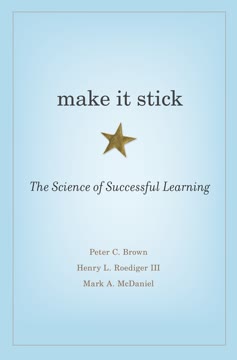Key Takeaways
1. Marketing is the Core Function of Every Successful Enterprise
No matter what business you are in, you are in the "marketing business."
Marketing drives success. The primary reason for a business's success or failure is determined by the effectiveness of its marketing efforts. Marketing is not just a department or function; it's the core of every successful enterprise. It involves identifying customer needs, creating products or services to meet those needs, and communicating the value proposition to potential customers.
Customer-centric approach. Successful marketing places the customer at the center of all planning and decision-making. This involves:
- Developing an obsession with customer service
- Continuous customer communication and interaction
- Regular market research and customer feedback
- Ensuring every employee sees themselves as a customer service representative
Marketing's impact on profitability. Effective marketing directly influences a company's bottom line by:
- Attracting a steady stream of qualified prospects
- Increasing customer acquisition and retention rates
- Enabling higher pricing through perceived value
- Expanding market share and brand recognition
2. Create and Keep Customers by Delivering Unique Added Value
The real purpose, however, as Peter Drucker explained, is to "create and keep a customer."
Unique added value. The key to successful marketing is creating perceptions of unique added value in the minds of your customers. This involves:
- Identifying specific customer needs or problems
- Developing products or services that address these needs better than competitors
- Clearly communicating the unique benefits to potential customers
Customer retention strategies. Creating customers is important, but keeping them is equally crucial and often more cost-effective:
- Provide exceptional customer service
- Continuously improve product quality
- Build strong relationships with customers
- Offer loyalty programs or incentives for repeat business
- Regularly seek and act on customer feedback
Focus on customer satisfaction. Satisfied customers are more likely to become repeat customers and brand advocates:
- Exceed customer expectations whenever possible
- Address customer complaints quickly and effectively
- Personalize the customer experience
- Regularly measure and track customer satisfaction levels
3. Understand Your Target Market and Ideal Customer
"Who are those customers, exactly, who most appreciate your area of specialization and your area of uniqueness or superiority, and who want exactly those features and benefits that you are most capable of delivering?"
Market segmentation. Effective marketing requires a deep understanding of your target market:
- Demographic factors: age, gender, income, education, occupation
- Psychographic factors: values, attitudes, interests, lifestyle
- Geographic factors: location, climate, population density
- Behavioral factors: purchasing habits, brand loyalty, product usage
Ideal customer profile. Develop a detailed profile of your ideal customer:
- What are their primary goals and pain points?
- What motivates their purchasing decisions?
- How do they prefer to receive information and make purchases?
- What is their decision-making process?
Market research. Continuously gather and analyze data about your target market:
- Conduct surveys, focus groups, and interviews
- Analyze customer data and purchase patterns
- Monitor industry trends and competitor activities
- Use social media and online analytics to gain insights
4. Develop a Clear Competitive Advantage
If you don't have a competitive advantage, don't compete.
Identify your strengths. Analyze your company's unique strengths and capabilities:
- Proprietary technology or processes
- Exceptional talent or expertise
- Strong brand reputation
- Superior customer service
- Cost advantages
Competitor analysis. Thoroughly understand your competitors:
- Identify direct and indirect competitors
- Analyze their strengths and weaknesses
- Monitor their marketing strategies and tactics
- Identify gaps in the market that you can fill
Develop and communicate your USP. Create a clear and compelling Unique Selling Proposition:
- Clearly articulate what sets you apart from competitors
- Focus on benefits that matter most to your target customers
- Ensure your USP is difficult for competitors to copy
- Consistently communicate your USP across all marketing channels
5. Implement Effective Positioning and Differentiation Strategies
Your positioning is contained in the words that customers use to describe you, and to describe your product and service to others.
Brand positioning. Develop a clear and consistent brand position:
- Define how you want your brand to be perceived
- Identify the key attributes and values associated with your brand
- Ensure your positioning aligns with your target market's needs and preferences
Differentiation strategies. Set yourself apart from competitors:
- Product differentiation: unique features, quality, or design
- Service differentiation: exceptional customer support or personalization
- Brand differentiation: strong brand identity and emotional connection
- Price differentiation: premium or value-based pricing strategies
Consistent messaging. Reinforce your positioning and differentiation through:
- Clear and compelling marketing communications
- Consistent brand voice and visual identity across all touchpoints
- Employee training to ensure alignment with brand positioning
- Regular evaluation and adjustment of positioning strategies
6. Utilize the Marketing Mix to Optimize Your Approach
The marketing mix is like a complex recipe for a special dish that you prepare in the kitchen. Each of the ingredients is essential.
Product strategy. Develop products or services that meet customer needs:
- Focus on quality and continuous improvement
- Offer a range of products to cater to different customer segments
- Regularly innovate and update your product offerings
Pricing strategy. Set prices that reflect value and maximize profitability:
- Consider cost-based, value-based, and competition-based pricing
- Use pricing to position your product in the market
- Implement dynamic pricing strategies when appropriate
Promotion strategy. Effectively communicate your value proposition:
- Develop an integrated marketing communications plan
- Utilize a mix of traditional and digital marketing channels
- Tailor messages to specific customer segments and buying stages
Place (distribution) strategy. Ensure your products are easily accessible to customers:
- Choose appropriate distribution channels (direct, retail, online, etc.)
- Optimize supply chain and logistics for efficiency
- Consider partnerships or alliances to expand reach
Additional marketing mix elements:
- People: Recruit, train, and motivate staff to deliver excellent customer experiences
- Process: Streamline internal processes to enhance efficiency and customer satisfaction
- Physical evidence: Create tangible cues that reinforce your brand and quality
7. Adapt Marketing Strategies from Military Principles
Think of yourself as a general in command of your "marketing forces."
Strategic planning. Apply military strategic thinking to marketing:
- Set clear objectives and develop a comprehensive plan
- Allocate resources effectively to achieve goals
- Anticipate and prepare for competitor responses
Offensive and defensive strategies:
- Offensive: Continuously innovate and seek new market opportunities
- Defensive: Protect market share and customer base from competitors
Principle of concentration. Focus resources on key areas of opportunity:
- Identify and prioritize high-potential market segments or products
- Allocate marketing budget and efforts to areas with the highest ROI
Element of surprise. Gain competitive advantage through unexpected actions:
- Launch innovative products or marketing campaigns
- Enter new markets or segments unexpectedly
- Use guerrilla marketing tactics for maximum impact
Intelligence gathering. Continuously monitor the market and competitors:
- Conduct regular market research and competitor analysis
- Utilize data analytics to gain insights and inform decision-making
- Develop a network of industry contacts for valuable information
8. Dominate a Market Niche for Maximum Profitability
Look for ways to introduce a new product or service combination into an existing marketplace where nobody is offering that particular product or service.
Identify underserved niches. Look for specific market segments with unmet needs:
- Analyze customer pain points and frustrations
- Identify gaps in existing product or service offerings
- Consider emerging trends or technologies that create new opportunities
Develop specialized offerings. Create products or services tailored to the niche:
- Focus on solving specific problems or fulfilling unique needs
- Offer superior quality or features compared to general market offerings
- Build expertise and reputation within the niche
Establish market leadership. Become the go-to provider in your chosen niche:
- Develop strong relationships with key customers and influencers
- Create barriers to entry for potential competitors
- Continuously innovate to stay ahead of the competition
Expand strategically. Once dominating a niche, consider expansion opportunities:
- Enter related niches or adjacent markets
- Scale the business model to reach a broader audience
- Consider licensing or franchising the specialized offering
9. Continuously Innovate and Explore New Growth Opportunities
People in business buy products and services to save or gain time or money.
Foster a culture of innovation. Encourage creativity and new ideas throughout the organization:
- Create processes for idea generation and evaluation
- Reward and recognize innovative thinking
- Allocate resources for research and development
Explore new growth strategies:
- Market penetration: Increase sales of existing products in current markets
- Product development: Create new products for existing markets
- Market development: Enter new markets with existing products
- Diversification: Develop new products for new markets
Leverage technology. Stay ahead of technological trends:
- Invest in digital marketing and e-commerce capabilities
- Utilize data analytics for better decision-making
- Explore emerging technologies like AI, IoT, or blockchain for potential applications
Strategic partnerships. Collaborate with other businesses for mutual benefit:
- Form joint ventures or strategic alliances
- Explore cross-promotional opportunities
- Consider mergers or acquisitions to accelerate growth
10. Embrace Change and Stay Ahead of the Competition
"Those who do not plan for the future cannot have one."
Anticipate market changes. Develop a forward-thinking mindset:
- Regularly analyze industry trends and emerging technologies
- Monitor shifts in customer preferences and behaviors
- Stay informed about economic, social, and regulatory changes
Adapt quickly. Build organizational agility to respond to changes:
- Create flexible business processes and systems
- Empower employees to make decisions and take initiative
- Regularly review and update strategic plans
Continuous learning. Foster a culture of ongoing education and improvement:
- Invest in employee training and development
- Attend industry conferences and networking events
- Encourage knowledge sharing within the organization
Experiment and iterate. Test new ideas and approaches:
- Use A/B testing for marketing campaigns and product features
- Implement lean startup methodologies for new initiatives
- Learn from failures and apply insights to future efforts
Stay customer-focused. Maintain a deep understanding of evolving customer needs:
- Regularly gather customer feedback and insights
- Use customer data to personalize experiences and offerings
- Anticipate future customer needs and preferences
Last updated:
FAQ
What’s "Marketing" by Brian Tracy about?
- Focus on Strategic Marketing: "Marketing" by Brian Tracy is a practical guide to understanding and applying strategic marketing principles to achieve business success.
- Core Function of Business: The book emphasizes that marketing is the core function of every successful enterprise, regardless of industry.
- 21 Key Ideas: Tracy presents 21 key marketing concepts, each designed to help readers improve their marketing results immediately.
- Action-Oriented Approach: The book encourages readers to take immediate action on new marketing ideas, fostering a sense of urgency and a bias for action.
Why should I read "Marketing" by Brian Tracy?
- Learn Proven Strategies: The book distills decades of marketing experience into actionable strategies that can be applied to any business.
- Avoid Common Pitfalls: Tracy highlights why nearly half of business failures are due to poor marketing, helping readers avoid these mistakes.
- Customer-Centric Focus: Readers will learn how to put the customer at the center of all business decisions, a key to long-term success.
- Practical and Accessible: The content is straightforward, filled with real-world examples, and designed for immediate implementation.
What are the key takeaways from "Marketing" by Brian Tracy?
- Purpose of Business: The real purpose of a business is to "create and keep a customer," not just to make a profit.
- Quality and Service: High-quality products and exceptional service are the most effective marketing strategies.
- Competitive Advantage: Businesses must develop a unique selling proposition and differentiate themselves from competitors.
- Continuous Improvement: Marketing strategies must be regularly reviewed and adapted to changing markets and customer needs.
How does Brian Tracy define the purpose of a business in "Marketing"?
- Creating and Keeping Customers: Tracy, echoing Peter Drucker, states the true purpose of a business is to create and keep customers.
- Profit as a Result: Profits are seen as the result of successfully creating and retaining customers, not the primary goal.
- Cost of Acquisition: The book stresses the importance of understanding and managing the cost of acquiring new customers.
- Emphasis on Relationships: Building strong, emotional relationships with customers is essential for long-term business success.
What are the "Four Approaches to Successful Marketing" in "Marketing" by Brian Tracy?
- Creating Utility: Offer products or services that fulfill a specific need or provide utility to customers.
- Pricing Properly: Adjust pricing to make products accessible to a broader market, leveraging economies of scale.
- Adapting to Customer Reality: Remove barriers to purchase by addressing customer fears and emphasizing key benefits.
- Delivering True Value: Work closely with customers to identify and deliver what they truly value, such as reliable service or support.
What is the "Marketing Mix" according to Brian Tracy, and why is it important?
- Seven Ps Framework: Tracy expands the traditional marketing mix to seven Ps—Product, Price, Promotion, Place, Packaging, Positioning, and People.
- Holistic Approach: Each element must be carefully managed and adjusted to achieve optimal marketing results.
- Continuous Revision: The marketing mix should be regularly reviewed and updated to respond to market changes.
- Impact on Success: A weakness in any one area can significantly affect sales and profitability.
How does "Marketing" by Brian Tracy explain why people buy?
- Felt Dissatisfaction: Purchases are driven by a desire to relieve dissatisfaction or solve a problem.
- Emotional Decision-Making: People buy based on emotions and justify their decisions logically afterward.
- Desire for Gain, Fear of Loss: The two primary motivators are the desire to gain benefits and the fear of losing something valuable.
- Focus on Outcomes: Customers buy the anticipated improvement or feeling they expect from using the product or service.
What is a "Unique Selling Proposition" (USP) and how does Brian Tracy recommend developing one?
- Definition of USP: A USP is the unique benefit or value that sets your product or service apart from competitors.
- Core of Marketing: Tracy advises making the USP the central message in all promotional materials and communications.
- Customer Perspective: The USP should be defined in terms of the specific benefits or outcomes valued by customers.
- Sustainable Advantage: Continually refine and promote your USP to maintain a competitive edge and avoid competing solely on price.
What are the "Four Principles of Marketing Strategy" in "Marketing" by Brian Tracy?
- Specialization: Focus on a specific product, service, customer segment, or market area to become a leader.
- Differentiation: Clearly distinguish your offerings from competitors, making your business the "only choice" for customers.
- Segmentation: Identify and target the ideal customer by understanding both demographics and psychographics.
- Concentration: Direct resources and efforts toward the most promising market segments and opportunities for maximum impact.
How does Brian Tracy suggest businesses should analyze and respond to competition?
- Identify Competitors: Know who your direct and indirect competitors are, including nontraditional threats like market ignorance.
- Understand Strengths and Weaknesses: Analyze both your own and your competitors’ strengths and weaknesses to find opportunities.
- Challenge Assumptions: Regularly question your beliefs about competitors to avoid complacency and missed threats.
- Strategic Alliances: Consider partnerships with noncompetitors to access new customers and markets.
What are some creative marketing growth strategies discussed in "Marketing" by Brian Tracy?
- Sell More to Existing Markets: Modify, bundle, or promote current products to increase sales within existing markets.
- Introduce New Products: Develop new offerings for your current customer base to meet additional needs.
- Enter New Markets: Expand geographically or target new customer segments with existing products.
- Joint Ventures and Alliances: Partner with other companies to distribute complementary products or access new markets.
What are the best quotes from "Marketing" by Brian Tracy and what do they mean?
- "The real purpose of a business is to create and keep a customer." — Emphasizes that customer focus, not profit, is the foundation of business success.
- "Quality is the most powerful and effective of all marketing strategies." — Highlights the importance of delivering high-quality products and services.
- "People are 100 percent emotional." — Reminds marketers that buying decisions are driven by emotions, not just logic.
- "If you don’t have a competitive advantage, don’t compete." — Stresses the necessity of differentiation to survive and thrive in any market.
- "Whatever you dwell upon, grows." — Encourages a mindset of continuous improvement and customer-centric thinking for business growth.
Review Summary
Marketing receives mostly positive reviews, with an average rating of 4.09/5. Readers appreciate its concise yet comprehensive coverage of marketing principles, finding it valuable for beginners and experienced professionals alike. Many praise Tracy's ability to distill complex concepts into practical advice. Some readers find it particularly useful for product-based businesses. Critics note that some information may be outdated or too basic. Overall, reviewers recommend it as a quick, insightful read for those looking to improve their marketing skills.
Similar Books








Download PDF
Download EPUB
.epub digital book format is ideal for reading ebooks on phones, tablets, and e-readers.














